NATCHEZ – Loyola Ministry Institute, New Orleans, will offer a graduate theology program under the sponsorship of St. Mary Basilica beginning September 2017, according to Father David O’Connor, pastor. The course work will be offered at the St. Mary Family Life Center, 613 Main St., Natchez.
Applicants may earn a master’s degree in religious education or pastoral studies, a diploma in theology and ministry or work on acquiring continuing education certificates in religious education or pastoral studies. Only those pursuing a master’s degree are required to do major research and write papers.
The entire program consists of 12 courses. The first six are presented in Natchez, and the remaining courses will be offered online. The later six courses may be done individually or in a local group setting. The course content, process and methodology is prepared by Loyola Institute of Ministry and will be facilitated by Ruth Powers on behalf of Loyola.
Participants will meet 10 times for each three-hour course. The day and time of these weekly meetings will be agreed on when the class members meet for the first time, possibly on a Monday evening. Library facilities are provided by St. Mary Basilica. Participants are expected to bring their life experiences to the study and will have the support of the study group. Each participant is expected to spend two to three hours of personal study between class meetings.
This program was offered 2009-2013 in Natchez. Members of that graduating class were: Gabriel Cassagne, Karen Verruchi, Charles Garrity, Ann Elizabeth Kaiser, Camille Durkin, Ginger Cowart, Wilbur Johnson, L.D. Lange, Valencia Hall and Sue Junkin.
“This study program not only gave me an in-depth understanding of the church teachings but also a new appreciation for my Catholic faith,” said Garrity.
Carrie Lambert, St. Mary Youth Director, is registered for the upcoming program.
“I want a master’s degree in religious education for my youth ministry so that I can be a better informed leader among the younger population,” she explained.
Father O’Connor commented, “This theology program is an opportunity for teachers to earn a master’s degree without leaving home, for clergy and parish leaders who are interested in continuing education, and for church members seeking personal updating and enrichment.”
The deadline for registration is July 15. Interested individuals should contact Donna Martello at St. Mary Basilica (601) 445-5616 or email her at ProgramCoordinator@cableone.net.
(Submitted by Father David O’Connor, pastor of Nachez St. Mary Basilica.)
Category Archives: Diocesan News
Pastoral Ministries workshop welcomes new class, graduates four
By Fran Lavelle
LOUISVILLE – Another great week was had Lake Tiak O’Khata for the Pastoral Ministries Workshop. The workshop sessions, Mass, retreat opportunities and social time all provided a relaxed learning environment for catechists, parish leaders and those seeking to deepen their faith. This annual offering is part of the certification program for catechists offered by the Office of Faith Formation. Participants take classes together in a certain sequence in order to learn and form relationships and to support one another in their ministries.
A huge thanks to Bishop Joseph Kopacz, Father Kevin Slattery and Father John Bohn for celebrating Mass for us during the week. Many participants stated that being able to have Mass every day really added to the overall effectiveness of the week. This year included fifteen Year I participants, a big jump from years past. Their cohort certainly started strong and no doubt will finish strong.
We congratulate Rhonda Bowden of Pearl St. Jude Parish. Amy Brooks of Jackson St. Peter Parish, Dave Monts of Starkville St. Joseph Parish and Patti Greene of Canton Sacred Heart and Gluckstadt Parishes for completing the Pastoral Ministries program. Next year’s workshop is set for June 3-7, 2018. (Fran Lavelle is the Director of Faith Formation for the Diocese of Jackson.)
Retiro de Primera Comunión
CORINTH – Los niños que se preparan para la Sagrada Comunion disfruten un día de retiro y convivio en la parroquia de St. James.
Grupo de adultos jovenes aprenden sobre la fe en una manera divertida
WINONA – Un grupo de 22 adultos jóvenes de la Catedral de San Pedro y Santa Teresita en Jackson, Nuestra Señora de las Victorias en Cleveland, St. James en Corinth y St. James en Tupelo se reunieron el sábado 3 de junio para un taller de YouCat en el Misión del Sagrado Corazón en Winona.
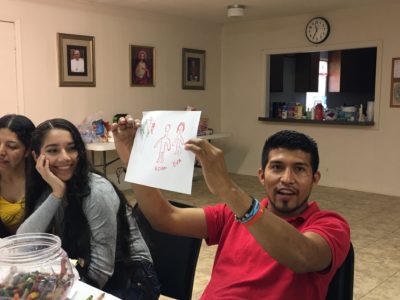
WINONA – Una de las dinámicas que los adultos jóvenes utilizaron para trabajar con el YouCat y así poder hacer más divertido y profundo su crecimiento en la fe.
También asistieron el padre Ted Dorcey de Greenwood y el seminarista Josean Montoya de Nueva York, ahora parte de los sacerdotes redentoristas del Delta. El grupo aprendió acerca de lo que es el YouCat, por qué fue escrito, para quién fue escrito y la estructura de sus preguntas y respuestas.
YouCat, que es corto para el Catecismo Juvenil de la Iglesia Católica, fue escrito para jóvenes de escuela secundaria y adultos jóvenes. Fue distribuido por primera vez en la Jornada Mundial de la Juventud 2011 en Madrid, España. YouCat contiene gráficos agradables, está escrito en forma de pregunta-respuesta y ofrece explicaciones, resúmenes y definiciones. También incluye citas bíblicas y citas de santos y otros. En la terminología que atrae a los jóvenes, el YouCat explica lo que nosotros los católicos creemos y por qué (doctrina), cómo debemos vivir (vida moral), y cómo debemos orar (oración y espiritualidad).
Después de una mañana llena de aprendizaje y exploración, los jóvenes pasaron la tarde participando en actividades y juegos en grupos pequeños.
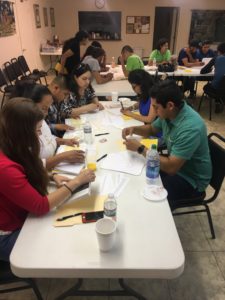
WINONA – El grupo de adultos jóvenes comparten sobre la estructura y formato del YouCat, el Catecismo de la Iglesia Católica, quien lo escribió y con qué motivo. Explican que el Papa Emérito Benedicto XVI tuvo la iniciativa de escribir el YouCat de una forma atractiva para los jóvenes en forma de preguntas y respuestas con símbolos, explicaciones y definiciones sencillas de comprender. (Fotos de Verónica López)
Grupos de jóvenes en Greenwood abrazan la diversidad de los miembros
Por Maureen Smith
GREENWOOD – A medida que la Diócesis de Jackson desarrolle las nuevas Prioridades Pastorales, Mississippi Católico compartirá las metas, proyectos e historias de éxito de diferentes grupos. El primero proviene de un ministro de la juventud en el Delta. Los grupos de jóvenes del Corazón Inmaculado de María y San Francisco de Asís están centrando su año en la prioridad de “abrazar la diversidad”.
“Tenemos alrededor de 30 niños en nuestro programa LifeTeen entre las dos parroquias”, dijo Derrick Faucheux, ministro de la juventud de ambas parroquias. “Y son todos de diferentes culturas.” La mitad son hispanos. El resto son afroamericanos o caucásicos. El grupo se ha estado reuniendo y conociéndose, pero Faucheux estaba listo para dar un paso más.

Durante la Jornada de la Juventud de Guadalupe, los adolescentes participaron en deportes y actividades al aire libre, pero también exploraron la espiritualidad hispana de la devoción a Nuestra Señora de Guadalupe. (Fotos cortesía de Derrick Faucheux)
Cuando el grupo comenzó a reunirse, Faucheux dijo que los niños no se sentaban todos juntos, pero se sentaban en grupos. “No estábamos seguros de cómo íbamos a romper ese molde”, dijo. Una noche, los estudiantes y un grupo de líderes adultos jugaron un juego de rompehielos y todo cambió. “Ni siquiera recuerdo lo que era el juego, pero esa noche, había una electricidad. Los chicos comenzaron a hablar entre sí “. Este avance fue el primer paso en un proceso de un mes para unir a los miembros del grupo.
“Estos niños van a cinco o seis escuelas diferentes, públicas y privadas, vienen de diferentes orígenes culturales, raciales y socio-económicos. Si no fuera por este grupo juvenil, probablemente nunca se hubieran conocido.
Cuando los estudiantes se sintieron más cómodos juntos, Faucheux comenzó a trabajar en formas de explorar sus antecedentes diversos como un grupo. Empezaron con un retiro en el centro de retiro Locus Benedictus en el borde de la ciudad. La reunión, el sábado 6 de mayo, ofreció una vislumbre de la devoción hispana a Nuestra Señora de Guadalupe. La comunidad Redentorista en Greenwood ayudó con la Jornada de la Juventud de Guadalupe, proporcionando información y la ubicación. Los estudiantes participaron en un juego de fútbol, un picnic y otras actividades al aire libre, pero también pasaron tiempo explorando cómo las culturas hispanas honran a Nuestra Señora de Guadalupe.
“La Iglesia Católica es universal. Aunque Nuestra Señora de Guadalupe es en su mayoría una devoción hispana, ella pertenece a todos”, dijo Faucheux. Quería que los adolescentes vean cómo pueden adorar o participar en devociones específicas de su cultura, pero también apreciar las devociones de otras culturas.
Faucheux planea ampliar estas lecciones durante el año, examinando la cultura y los líderes católicos afroamericanos, el catolicismo del sur, cualquier cosa que muestre a los estudiantes cómo pueden ser diversos, pero también unificados. “Quiero que los niños vean que la Iglesia es universal.” Algunos miembros del grupo de jóvenes fueron a Abbey Youth Fest juntos. El viaje permitió a los adolescentes pasar mucho tiempo juntos para conocerse mejor dentro de un contexto católico.
Faucheux asistió a una reunión nacional de ministros de jóvenes en la que preguntó a otros sobre sus desafíos con la diversidad. “Pocos tienen un grupo tan diverso como este”, dijo. El Delta de Mississippi es único en su mezcla de culturas. En lugar de sentirse desanimado, Faucheux considera que el reto es la manera perfecta de mostrar cómo la Iglesia Católica puede abrazar a todos. “Algo me decía que pusiera a todos estos niños juntos porque es un testimonio de la Iglesia Católica que podemos estar juntos, somos universales”.
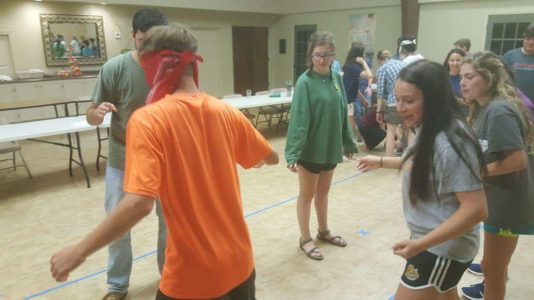
GREENWOOD – El líder del ministerio juvenil Derrick Faucheux dijo que un rompehielos proporcionó una oportunidad para que sus grupos de jóvenes comenzaran a comunicarse unos con otros.
Equipo bilingüe de recursos de la Prioridad Pastoral ayudará a las parroquias con el despliegue del plan
Por Maureen Smith
GLUCKSTADT – Los miembros del equipo de recursos de la Prioridad Pastoral del Obispo Joseph Kopacz se reunieron el sábado 3 de junio en la parroquia St. Joseph para exponer sus planes para ayudar a las parroquias a implementar las nuevas prioridades pastorales de la Diócesis de Jackson. Las prioridades forman parte de una nueva misión y visión que la diócesis viene formulando desde hace más de un año.
El Obispo Kopacz recorrió la diócesis para presentar la misión, la visión y las prioridades e invitó a cada pastor y ministro laico a incorporarlos en la obra de su parroquia.
Los equipos de recursos bilingües acompañarán a las parroquias a medida que establezcan metas nuevas y alineen su trabajo con las prioridades utilizando recursos en inglés y español. Los miembros del equipo están disponibles para reunirse con los equipos parroquiales o pastores que quieren orientación adicional y reportarán el progreso al obispo regularmente. Cada miembro del equipo se asociará con varias parroquias para que cada uno tenga una persona de contacto. Pero los equipos de las parroquias establecerán sus propias metas para ajustarse a los sueños de sus comunidades.
“Realmente queremos que esto sea un esfuerzo de base, pero queremos apoyar el trabajo de las parroquias en todas las formas posibles”, dijo el padre Kevin Slattery, vicario general y líder del equipo.
En la reunión, los miembros del equipo hablaron sobre lo que ya están escuchando de algunas parroquias y sobre maneras de compartir las mejores prácticas y recursos con los equipos parroquiales. El plan, junto con algunos recursos preliminares, está disponible en línea en https://jacksondiocese.org/vision.
Bishops also address religious liberty, healthcare, sacramental guidelines
The U.S. Conference of Catholic Bishops (USCCB) tackled a number of issues during its spring meeting in Indianapolis. Here is a brief outline of some of their actions other than the safe environment report.
• The bishops voted June 15 to make the Ad Hoc Committee for Religious Liberty a permanent standing committee. The bishops’ action came less than a week before the start of the U.S. Conference of Catholic Bishops’ fifth annual Fortnight for Freedom June 21-July 4. It is a two-week period of prayer, advocacy and education on religious freedom.
• Bishop Oscar Cantu of Las Cruces, New Mexico, and chairman of the U.S. Conference of Catholic Bishops’ Committee on International Justice and Peace, briefed his brother bishops on the sobering topic of international persecution and human rights violations, and what his committee has been doing the prelates behalf to improve the situation. Bishop Cantu’s trips are called “solidarity visits.” His mandate as chairman “includes sharing and promoting the social teaching of the church, especially human rights and religious freedom.”
• As the country awaits the U.S. Senate’s plan to repeal and replace the Affordable Care Act in the coming weeks, the U.S. bishops made it clear that their efforts are focused on “ensuring the fundamental right of medical care” for all people. The Conference also reinforced its stand that the American Health Care Act passed by the U.S. House May 4 needs major reform – to provide quality health care for the “voiceless,” especially children, the elderly, the poor, immigrants and the seriously ill. “Within two weeks, we may see a federal budgetary action with potentially catastrophic effects on the lives of our people, most especially children and the elderly, the seriously ill, the immigrant and our nation’s working poor,”said Bishop George L. Thomas of Helena, Montana, in his remarks to his fellow bishops.
• The body overwhelmingly approved revisions to the guidelines governing the celebration of sacraments for people with disabilities that take into account medical and technological developments. The revisions in the “Guidelines for the Celebration of Sacraments with Persons with Disabilities” updates a document that was adopted in 1995. The guidelines were developed as a tool to improve access to the sacraments by persons with disabilities and reduce inconsistencies in pastoral practice.
Graduation 2017 stats
St. Joseph School – Greenville

Graduates: 44
Graduation rate: 100 percent
College bound: 100 percent
Scholarship recipients: 86 percent
Largest scholarship awarded: $450,000
Scholarships total: $4.2 million
Class service hours: 4,405
Notable colleges: Texas Lutheran; Washington University, St. Louis; Emerson, Boston, West Point
Notable service projects: Inaugurated memorial garden and senior patio in honor of their classmate, Parker Jones, who lost her battle with brain cancer when they were freshmen.
VALEDICTORIAN: ASIA CARLYN-MARIE HARDEN

ASIA CARLYN-MARIE HARDEN
GPA: 4.38 – ACT: 28
From her speech: So as you continue to grow, remember to shed light onto the people you meet. Leave them a little better than when you came. Be generous with your smiles, and remember that kindness costs you nothing. Truly, we’ve been given an opportunity, a gift to be whoever we want to be as long as we’re willing to fight for the life we want to lead: Lives full of service, love, determination, hope and the most genuine happiness.
Member of: House of Prayer Church of God in Christ
Scholarships: Lucky Day Success, University of Mississippi (UM) Chancellor’s Leadership, UM Academic Excellence, Bledsoe Scholarship, UM Alumni, Rotary 4-way Test, Church’s Chicken Community Scholarship, JA Scholarship, 100 Black Men of the Mississippi Delta, Francis P. and Annie C. Unkel Trust Scholarship
Awards/honors: President of NHS, Vice President of Mu Alpha Theta, President’s Volunteer Service Award, Rotary 4-way Test, Mississippi Scholar, Chuck Early Humanitarian Award, Magnolia Girls’ State
Activities: Cheerleader captain, soccer, SJS Ambassador, YADA (Youth Against Drugs and Alcohol), Quiz Bowl, Interact Club
Favorite subject: English
Favorite service project: Attending HOBY as a junior counselor because I was able to help other students discover service opportunities in their communities and watch them grow
Plans to attend: University of Mississippi
Plans to study: integrated marketing communications
SALUTATORIAN: JENNIFER MANSOUR

JENNIFER MANSOUR
GPA: 4.37 – ACT: 32
From her speech: While we were fortunate enough to become a family and have each other to share memories with, we were blessed to grow up in a Catholic environment. Since K-5, morning prayer and religion class have always been a part of our routine. However, it was not until recently that I began to realize how my Catholic education shaped me into who I am today. As I grew, my faith grew along side of me. While we were trying to figure out who we were, we were constantly reminded of the person God wants and means for us to be. We not only had our friends and family to turn to in times of need but we had our faith. I will forever be grateful for the opportunity to learn about and practice my faith every single day alongside my friends… With growing up comes new responsibility. It is now our responsibility to live out our faith without our school or parents by our sides. We owe it to ourselves to stay true to who we are.
Member of Greenville St Joseph Parish
Scholarships:Accepted: Washington University Thomas Eliot Scholarship, Mu Alpha Theta High School Scholarship, Washington County Farm Bureau Federation Scholarship Others: University of Mississippi, Bledsoe Scholarship, Star Student
Awards/honors: Contributed to publication of Mississippi State Medical Association, Best of Fair Overall MAIS Science Fair, Star Student, Wendy’s Heisman State Finalist, 2015 MAIS State Champion (Swim-100 yd freestyle), 2015 MAIS State Runner-up (Swim-50 yd freestyle), Mississippi All Star Zone Swim Team, Homecoming senior princess, Delta Council Honor Graduate, MAIS Don Souder Award Nominee, Woodman of the World American History Award, Outstanding Performance Drama Award, Outstanding Contributions Principal’s Award for Service
Activities: Student Government President, Mu Alpha Theta President, National Honor Society, Scholars Bowl team captain, Delta Aquatic Club Swim Team, Interact Club, School Ambassador, Greenville Arts Council Volunteer, Carrie Stern Elementary School Reading Buddy, Chairman of SJCS Blood Drive, swim instructor
Favorite subject: Mathematics
Favorite service project: Summer volunteer at Greenville Arts Council Summer Arts Camp. I enjoyed working with the kids and seeing their creativity.
Plans to attend: Washington University, St Louis MO
St. Aloysius – Vicksburg
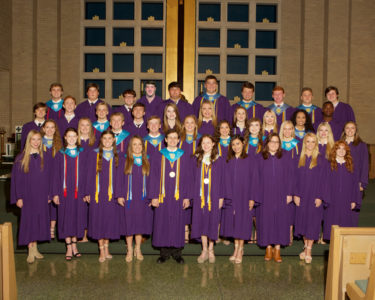
Graduates: 40
Graduation rate: 91 percent
College bound: 95 percent
Scholarship recipients: 73 percent
Largest scholarship awarded: $500,000
Scholarships total: $3.6 million
Class service hours: 5,934
Notable colleges: Naval Academy, United States Army
Notable service projects: Good Shepherd Community Center
VALEDICTORIAN: ANNA KATE DOIRON

ANNA KATE DOIRON
GPA: 4.64 – ACT: 30
From her speech: This school is amazing. Teachers truly care about every single student, and they want you to excel no matter how bad you get on their nerves. There are so many opportunities at St. Aloysius that a big public school just cannot provide. Every student has a name. Nobody gets lost in the crowd. I never see an unfamiliar face walking down the hall.
There’s something to be said about someone who comes to a new school with fresh eyes and past experiences. It was all new to me — the service, classes being more like families, and I truly appreciated it. I have honestly never seen a woman more devoted to service than Mrs. Thornton. She showed us the importance of putting others first. Each service hour sheet filled strengthened our faith and character, but the concern did not stop with members of our school. Needs of every aspect of our community are met with project after project…Our (senior retreat) theme was ascending the mountain to become a people of the gospel. And wow were we successful! A huge leap of faith was taken, and all trust was put into our senior advisors. We ascended the mountain in Cary, Mississippi, and came together as a class in a way the teachers said they had never seen before. We are all about to take one more leap of faith, one that’s bigger than any leap we’ve ever taken, and who knows where we’ll land.
Member of Vicksburg St. Michael Parish
Scholarships: Accepted: University of Mississippi Academic Leadership and Academic Excellence; Bledsoe, Herb Dewees Alumni Association, Chick Fil A Leadership, Y’s Men Club Flanagan Memorial, Anthony Cozzani Memorial Award Other: Mississippi College Academic
Awards/honors: Gold Presidential Service Award, St. Aloysius A Award, 4.0 award
Activities: yearbook, soccer, Chick Fil A Leadership Academy, retreat team
Favorite subjects: Math
Favorite service project: Senior retreat and working at Good Shepherd Community Center
Plans to attend: University of Mississippi
Plans to study: business
SALUTATORIAN: CHARLIE MARTIN

CHARLIE MARTIN
GPA: 4.62 – ACT: 33
From his speech: Yes, we have been taught the basics of reading, writing, and arithmetic. But, we have also learned so much more throughout our years here, which has molded us into who we are today. Coach Bruce Ebersole has taught us to “Enjoy the speed!” by working hard and enjoying our accomplishments; and this year St. Aloysius has experienced the joy of athletic and academic success. Thanks to Mr. Brantley some of us even learned that physics is fun. In biology we learned not to get out of our cars to pick wildflowers next to the highway. We have learned that sometimes when we take risks, we can actually succeed at what first seems impossible.
It is often said that all good things must come to an end. As we reach the end of our time here together, we can look towards the bright future that lies ahead of us. As we go out into the world we will cherish the experiences and remember the lessons we have learned at St. Aloysius. We are all heading to many different places, leaving St. Aloysius no longer as “One fish, Two fish, Red fish, Blue fish,” but as “Purple fish, Gold fish, Twenty fish, Seventeen fish.”
Member of Holy Trinity Episcopal Church
Scholarships: Accepted: Purdue Alumni Scholarship, Knights of Columbus Essay Scholarship, Daughters of the American Revolution Ashmead Chapter, Junior Auxiliary of Vicksburg, Merit Health River Region, Joe and Feeney Elliott Scholarship. Others: Mississippi State Star Student, Mississippi College Math and Science, MSU Academic Excellence
Awards/honors: St. Aloysius Service Award, Lombard Burns Memorial Award, STAR Student, St. Aloysius Silver A Award, 4.0 award
Activities: Varsity Swim Team, Quiz Bowl, Siege Robotics Team, Math and Science Team
Favorite Subjects: AP Biology
Favorite service project: Helping at Vicksburg Community Center. This project allowed me to help and interact with those people in need in the community.
Plans to attend: Purdue University
Plans to study: biomedical engineering
Cathedral school – Natchez

Graduates: 40
Graduation rate: 100 percent
College bound: 100 percent
Scholarship recipients: 100 percent
Largest scholarship awarded: $284,328
Scholarships total: $1.6 million
Class service hours: 1,600
Notable colleges: Chaffey College in Rancho Cucamonga, Ca.; Fashion Institute of Design & Merchandising, Los Angeles, Ca.
Notable service projects: : Food Drive for Stewpot; Bake sale to raise funds for senior, Sydney Jackson, to purchase a diabetic dog to take to college
VALEDICTORIAN: EMILY DAWSON HOOTSELL

EMILY DAWSON HOOTSELL
GPA: 4.436 – ACT: 29
From her speech: Channing Tatum and the more renowned William Shakespeare once said, “Be not afraid of greatness: some are born great, some achieve greatness, and some have greatness thrust upon them.” I am proud to be a member of this class of 2017 because I know we will continue to work at becoming great in all our endeavors. I know this to be true because my class is one of the most strong-willed and competitive groups of people I know, and we will not stop until we have achieved all of our goals. Fellow graduates, I challenge you to run as fast as we did for chicken strip day towards your goals, I know quite a few of us are undecided about what we want to do with our lives in terms of careers, but I believe we all will be successful because we refuse to be anything less. Look around — we made it! AND, we will continue to achieve greatness in college and careers.
I leave you with these words from of my favorite philosopher in rhyme — Dr. Seuss: “You have brains in your head. You have feet in your shoes, you can steer yourself any direction you choose. You’re on your own. And you know what you know. And you are the one who’ll decide where to go. You’re off to great places! Today is your day! Your mountain is waiting, so get on your way!”
Member of Natchez St. Mary Basilica
Scholarships: Accepted: Rotary Club Scholarship, Mississippi College Academic Scholarship, and Mississippi Eminent Scholarship Grant Others: Academic Excellence from University of Southern Mississippi
Awards/honors: 90+ Average each year; All American Dance
Activities: shooting, archery
Favorite service project: Food drive for Stew Pot. Working at Stew Pot helped me see how important it is to keep food coming in so that the Stew Pot can continue to serve more than 500 plates daily.
Plans to attend: Mississippi College
Plans to study: pre-med; business
SALUTARORIAN: ZACHARY TAYLOR FLATTMANN
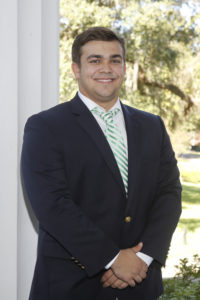
ZACHARY TAYLOR FLATTMANN
GPA: 4.427 – ACT: 29
From his speech: If there is one thing I want the class of 2017 to remember tonight, it is this — we all have a purpose in life, from day one God has had a plan for us and we all can make a difference. No matter what field you may go into, no matter what college you go to, and no matter where you end up beginning a family, we all have a purpose and can make a difference in this troubled world we live in.
I would like to bring in this quote from a work we read in our AP English class this year. It comes from the writer Lord Alfred Tennyson,“To strive, to seek, to find, and not to yield.” We all have a goal we wish to achieve, whether it is to start on the football or baseball team next year, or become a doctor or the next Einstein, we all have something to reach for in life. We should always strive towards our goal, seek the routes to accomplish it, and finally find the finish line. But, we should never yield to any obstacle we may face; instead, face them head on and never alter your path. Life will throw us curveballs, but when the time comes, plant your feet into the ground and knock that ball out of the ball park. You can do anything you set your mind to, just BELIEVE. And if you are ever faced with a difficult time and cannot figure it out, you can always turn to our Lord up above for guidance and peace, for He is the one that will bring us all to eternal life.
Member of Natchez St. Mary Basilica
Scholarships: Accepted: Mississippi University for Women, full academic scholarship. Others: Louisiana State University; University of Mississippi; Mississippi State University
Awards/honors: 90+ average for four years; CARE award; All-district catcher; Jon and Jennifer Steckler Scholarship; President of National Honor Society; VP of Science National Honor Society; National Football Foundation Hall of Fame; South State Baseball Champions for three years; Baseball State Champion; South State and State Football Champion; All-District First Team in baseball; All-District 2nd Team in Football; participated in the Mississippi State game; elected for All-Star game his senior year; Rookie of the year in Football Freshman year; MVP for baseball; Will be a member of the first male baseball team at Mississippi University for Women.
Activities: baseball and football
Favorite subject: Mathematics
Favorite service project: Bayou Bandits Assistant Coach
Plans to attend: Mississippi University for Women
Plans to study: biomechanical engineering
St. Joseph – Madison
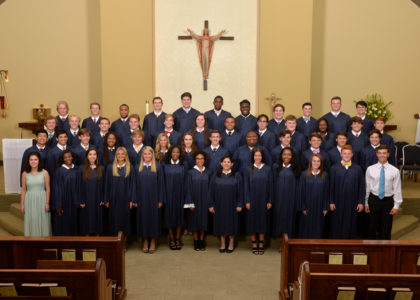
Graduates: 50
Graduation rate: 100 percent
College bound: 98 percent
Scholarship recipients: 92 percent
Largest scholarship awarded: $375,000
Scholarships total : $3.7 million
Class service hours: 11,001
Notable colleges: United States Coast Guard Academy; New London, Ct.; Rhodes College
Notable Service Projects: Bruinthon: Students danced and engaged in competitive activities from 4:00 p.m. until midnight and raised $15,311 for the Blair Batson Children’s Hospital
VALEDICTORIAN: ANDREW S. LEISS, JR.

ANDREW S. LEISS, JR.
GPA: 4.40 – ACT: 35
From his speech: As many of my fellow graduates know, I neglected taking an essential, full semester online course until two weeks before it was due. Those two weeks were spent in a frantic panic trying to complete the course – something that was only possible because of motivation from my parents and allowances from my teachers. This kind of academic cooperativeness is paramount to the atmosphere cultivated at St. Joseph. People do not hoard notes or study guides, or refuse to catch you up if you were unfortunate enough to miss a class. St. Joe students put the success of their peers at the same level as they put their own.
Students often go out of their way to help others with class work, which is something I can personally attest to. It is a very selfless learning environment – Caroline Doherty gave me more English study guides than I can count, Ellie Smith had to explain Calculus to me almost every day, and Nathan Lancaster was my secondary physics teacher for a decent chunk of the year. While I was helped by many St. Joe classmates, I mentioned these three names for a reason – they were the others students with the grades to be valedictorian. Even though the decision came down to tenths of a point – which could be dictated by a single test grade – these four students never stopped helping each other. People at St. Joe don’t want to succeed because they let someone else fail – they want to succeed because of their own ability and merit. This support system extends far beyond academics.
Member of Gluckstadt St. Joseph Parish
Scholarships: Accepted: Merit Scholarship Others: Ignatian Scholarship, Loyola University, New Orleans; Hendrix College, Denison University, Centre College, University of Mississippi
Awards/honors: President of the National Honor Society, Mu Alpha Theta, National English Honor Society, National Junior Classical League
Activities: Band, orchestra pit for musical, volunteer for Jackson Friends of the Animal Shelter and Hope Hollow Summer Camp, bowling, Quiz Bowl, soccer and swim.
Favorite subject: Physics/English
Favorite service project: Jackson Friends of the Animal Shelter showed me that I have a love of animals, and that is an avenue of service that I wish to continue.Plans to attend: Rhodes College
Plans to study: biology, physics, pre-med
SALUTARORIAN: CAROLINE DOHERTY

CAROLINE DOHERTY
GPA: 4.39 – ACT: 34
From her speech: …I am blessed to have been a part of such a supportive learning environment. Each of my
teachers has challenged me to achieve my maximum potential while still caring about me personally. Mrs. Dickson encouraged me to expand my horizons and apply to out of state colleges and Mrs. Luscomb taught me to be confident in my abilities. Mrs. King showed me that poetry can actually be enjoyable sometimes and Mr. Theriot taught me that I could succeed in the most difficult classes if only I worked hard enough. The past four years have not been easy, but I know that my work has not been in vain. The greatest blessing I have received is a Catholic education, and I’m so incredibly blessed to continue this journey in college. I chose to only apply to Catholic colleges because I knew it was the type of environment I wanted to be in for the next four years.
To all the parents who have made sacrifices to send us to St. Joe, we thank you. St. Joe has provided many opportunities for each of us, and the class of 2017 has received the best possible foundation for a lifetime of
success.
Member of Jackson St. Richard of Chichester Parish
Scholarships: Accepted: Saint Louis University Presidential Finalist Scholarship, Saint Louis University Enhanced Merit Scholarship, Burger King Scholarship, Spirit of the Ridgeland Junior Diplomats Scholarship Others: Villanova University Scholarship, Georgetown University John Carroll Scholarship
Awards/honors: Diocese of Jackson Bishop John Joseph Chanche Youth Medal, National Merit Finalist, 2016 MHSAA All State cross country, AP Scholar, 2017 Bishop Joseph R. Kopacz Catholic Witness Award, 2017 Bruin Award, Gospel Service recognition for 555 Hours, Departmental Awards in Religion, Mathematics, and Social Studies
Favorite subject: History
Favorite service project: : Volunteering at Hoops Basketball, a league for special needs children and adults. It was so rewarding to see the participants get such joy out of just playing basketball and I was able to help some of the players improve their skills.
Plans to attend: St. Louis University
Plans to study: pre-med
Other Catholics who earned honors:
Heritage Academy
VALEDICTORIAN: Allie Kerby

ALLIE KERBY
GPA: 4.00 – ACT: 30
From her speech: The ultimate goal of life is individual success formed in a distinguishing, personal manner that reflects one’s character and achievements. I believe it is impossible to measure success with one word or one accomplishment, but true fulfillment is wrought by following God’s plan for us. Graduation from high school and moving into the unknown is similar to walking our faith journeys; we experience some uncertainties and obstacles that may make success seem doubtful, but through perseverance and trust we will reach success. The Class of 2017 is ready to start our new chapter and make a difference. We chose Colossians 3:23 to guide our senior year. It states, “Whatever you do, work at it with all your heart, as working for the Lord, not for men.” This verse reminds us to devote all of our effort towards fulfilling our future to ultimately graduate life and spend eternity in heaven with our Lord. Graduation does not end tonight; rather, it marks the beginning of the many graduations we will experience throughout life.
Thank you to parents, faculty, staff, coaches, friends, and family for the constant support, love, and guidance you have given each of us. The knowledge we have gained from every one of you during our 18 years will stick with us throughout the years to come.
Member of Columbus Annunciation Parish
Scholarships: Accepted: Mississippi State University Academic Excellence, valedictorian and Study Abroad scholarships; C. B. Mitchell Pre-Medicine Scholarship; Eminent Scholar
Awards/honors: : Highest average in: AP Chemistry, government, economics, Mississippi studies; National Honor Society; National Beta Club; Mu Alpha Theta Honors Society; MAIS Honors Society; National Society of High School Scholars; Heritage Academy Hall of Fame, Wendy’s High School Heisman recipient, 2017 MAIS 2 AAA discus champion
Activities: Mu Alpha Theta Math competition, Old Capitol Quiz Bowl, Junior Auxiliary Charity Ball, First United Methodist youth group, Annunciation Parish youth group, Varsity Basketball captain, SCA Social Club, Varsity basketball, track and field.
Favorite subject: Chemistry
Favorite service project: Loaves and Fishes Soup Kitchen
Plans to attend: University of Mississippi
Plans to study: biochemistry
STARKVILLE ACADEMY
SALUTATORIAN: HANNAH ROSE CUEVAS

HANNAH CUEVES
GPA: 4.00 – ACT: 23
From her speech: I have always been a strong believer in the quote “everything happens for a reason.” In fact it’s my senior quote. But when I moved from Pensacola I could not figure out the reason until I met these people. I realized I was wrong the entire time. I would not be who I am without the backing of Starkville Academy and the people who influenced me every day. It is my home. It is all of your homes, and nothing will ever change that.
While I was writing this speech one song lyric kept coming to my head. It says “Be a best friend, tell the truth, and overuse I love you.” Starkville Academy has taught me the value of friendship. Through my many memories at this school, there have been so many great ones and a few bad ones that I’ve learned from. My best friends have been by my side through all of them. Starkville Academy has given me family, not just friends. I have also learned to always tell the truth. As many of you know, I physically cannot lie, but that does not mean I didn’t try to. I have learned that friendships grow from honesty. “And overuse I love you” sticks out the most to me. If you haven’t told your parents that you love them today, please do so after graduation. Many of us don’t realize everything they do for us everyday. None of us would be sitting here today without them. Also, thank your teachers. They have impacted us in more ways than we realize.
Member of Starkville St. Joseph Parish
Scholarships: Accepted: Mississippi State Freshman Academic Excellence Scholarship, Anchor Club Scholarship, Oktibbeha County Alumni Chapter Annual Scholarship, Starkville Academy Scholar/Athlete Scholarship, Knights of Columbus/Kiwanis Scholarship
Awards/honors: Starkville Academy Hall of Fame, Scholar Athlete, Wendy’s Local High School Heisman, All Area girl’s basketball team, MAIS soccer All Star,MAIS All District soccer team, 2017 MAIS State soccer champions, 2017 Homecoming Queen, National Honor Society, first place District Science Fair, Rotary Club student of the month
Activities: Basketball, soccer, track, student council, theater
Favorite subject: Math
Favorite service project: Habitat for Humanity
Plans to attend: Mississippi State University
Plans to study: biomedical engineering
LEE ACADEMY
SALUTARORIAN:Lauren Agostinelli

LAUREN AGOSTINELLI
GPA: 4.00 – ACT: 30
(Agostinelli did not have to submit a speech)
Member of Clarksdale St. Elizabeth Parish
Scholarships: Salutatorian Scholarship, Girls’ State Scholarship, Academic Excellence, Star Student Scholarship, Study Abroad Scholarship, Key Club Scholarship
Awards/honors: Hall of Fame, Honor Graduate, American Legion Citizenship Award, National Honor Society, Mu Alpha Theta, Exchange Club Student of the Month, Delegate for Girls’ State.
Activities: soccer, young life, Campaigner’s Bible Study
Favorite subject: English
Favorite service project: : Work Crew for a Younglife campaign
Plans to attend: Mississippi State University
Plans to study: political science
Greenwood youth groups embrace diversity of members
By Maureen Smith
GREENWOOD – As the Diocese of Jackson rolls out the new Pastoral Priorities, Mississippi Catholic will feature goals, projects and success stories from different groups. The first comes from a youth minister in the Delta. The youth groups from the Immaculate Heart of Mary and St. Francis of Assisi are focusing their year on the priority of ‘embrace diversity.’
“We have about 30 kids in our LifeTeen program between the two parishes,” said Derrick Faucheux, youth minister for both parishes. “And they are all from different cultures.” Half, he said, are Hispanic. The rest are African-American or white. The group has been meeting and getting to know one another, but Faucheux was ready to take them a step farther.
When the group started meeting, Faucheux said the kids did not all sit together, but would cluster in groups. “We were not sure how we were going to break that mold,” he said. One night, the students and a group of adult leaders played an icebreaker game and everything changed. “I don’t even remember what the game was, but THAT night, there was an electricity in the room. The kids started actually talking to each other,” he explained. This one breakthrough was the first step in a months-long process to unite the members of the group.
“These kids go to five or six different schools, public and private, they come from different cultural, racial and socio-economic backgrounds. If not for this youth group, they probably would never have known each other at all.”
Once the students got a little more comfortable together, Faucheux started working on ways to explore their diverse backgrounds as a group. They started with a retreat-style gathering at the Locus Benedictus retreat center on the edge of town. The gathering, Saturday, May 6, offered a glimpse into the Hispanic devotion to Our Lady of Guadalupe. The Redemptorist community in Greenwood helped with Guadalupe Youth Day, providing insight and the location. The students participated in soccer, a picnic and other outdoor activities, but also spent time exploring how Hispanic cultures honor Our Lady of Guadalupe.
“The Catholic Church is universal. Even though Our Lady of Guadalupe is mostly a Hispanic devotion, she belongs to everyone,” Faucheux said. He wanted the teens to see how they can worship or participate in devotions specific to their culture, but also appreciate the devotions of other cultures.
He plans to expand these lessons throughout the year, examining African-American Catholic culture and leaders, Southern Catholicism, anything that will show the students how they can be diverse, but also unified. “I want the kids to see that the Church is universal,” he said.
Some members of the youth group went to Abbey Youth Fest together. The trip allowed the teens to spend a long time together getting to know one another better within a Catholic context.
Faucheux attended a national gathering of youth ministers where he asked others about their challenges with diversity.
“Very few of those leaders have a group as diverse as this one,” he said. The Mississippi Delta is unique in its blend of cultures. Far from being discouraged, Faucheux finds the challenge to be the perfect way to showcase how the Catholic church can embrace everyone. “Something was telling me to put all these kids together because it is such a witness to the Catholic Church that we can be together, we are universal.”
Jennifer David to lead St. Richard School
By Maureen Smith

Jennifer David
JACKSON – Jennifer David will take over as principal of St. Richard School in July. For the past three years, she has been the principal at Meridian St. Patrick School. Prior to that, she was assistant principal at Columbus Annunciation School, where she also taught for 18 years.
During her time at St. Patrick, David oversaw the addition of an eighth grade, a $1.2 million facilities expansion which added three classrooms, the creation of a mobile technology lab as well as adding one-to-one Chromebooks for the middle school students. David is quick to spread the credit around. “It took every person under this roof to make all that happen,” she said of the school’s growth. St. Patrick added fiber optic and wireless technology to enhance the technology the teachers can access in their classrooms.
“I love technology for what it can do for us, which is hopefully make our lives easier,” said David. “We want to make sure our students are prepared for the future. Technology keeps the kids interested and motivated and is easy to integrate into what we (educators) do,” she added.
High tech is not her only focus, David said she has always loved the Whole Schools model, which uses arts as a base for teaching. “St. Richard is a model school for Whole Schools and I love that,” said David. “Arts and technology – that’s where it’s at. Students are really going to learn when you can use those two things. They need to get involved in learning,” she said.
Father John Bohn, pastor at St. Richard, said he is excited to welcome the new leader. “She brings with her a great wealth of experience in Catholic education, both as a student and administrator,” said Father Bohn. “She already thinks very highly of St. Richard and will be good for the school, plus, being able to send her own daughter to St. Joe is an added bonus,” he added.
David and her husband have three daughters, Lauren, Ashley and Mary Kathryn. Her youngest will attend Madison St. Joseph High School in the fall.
David holds a masters in educational leadership from Marymount University. While she was working on the degree one theme kept recurring. “I remember writing a lot about servant leadership. I’m here to serve,” she explained of her leadership style. She said she wants to be a resource for parents, students and teachers. “I want to make sure the teachers have what they need to be successful and meet the needs of their diverse learners.”
David added that her faith is a big part of her vocation as an educator. “I am relying on my faith every day. You can’t give what you don’t have,” she said. She is looking forward to working with other Catholic educators in Jackson. “I’m so excited about having other Catholic schools and other principals with whom I can collaborate. It will be great to have a support system,” she said.
